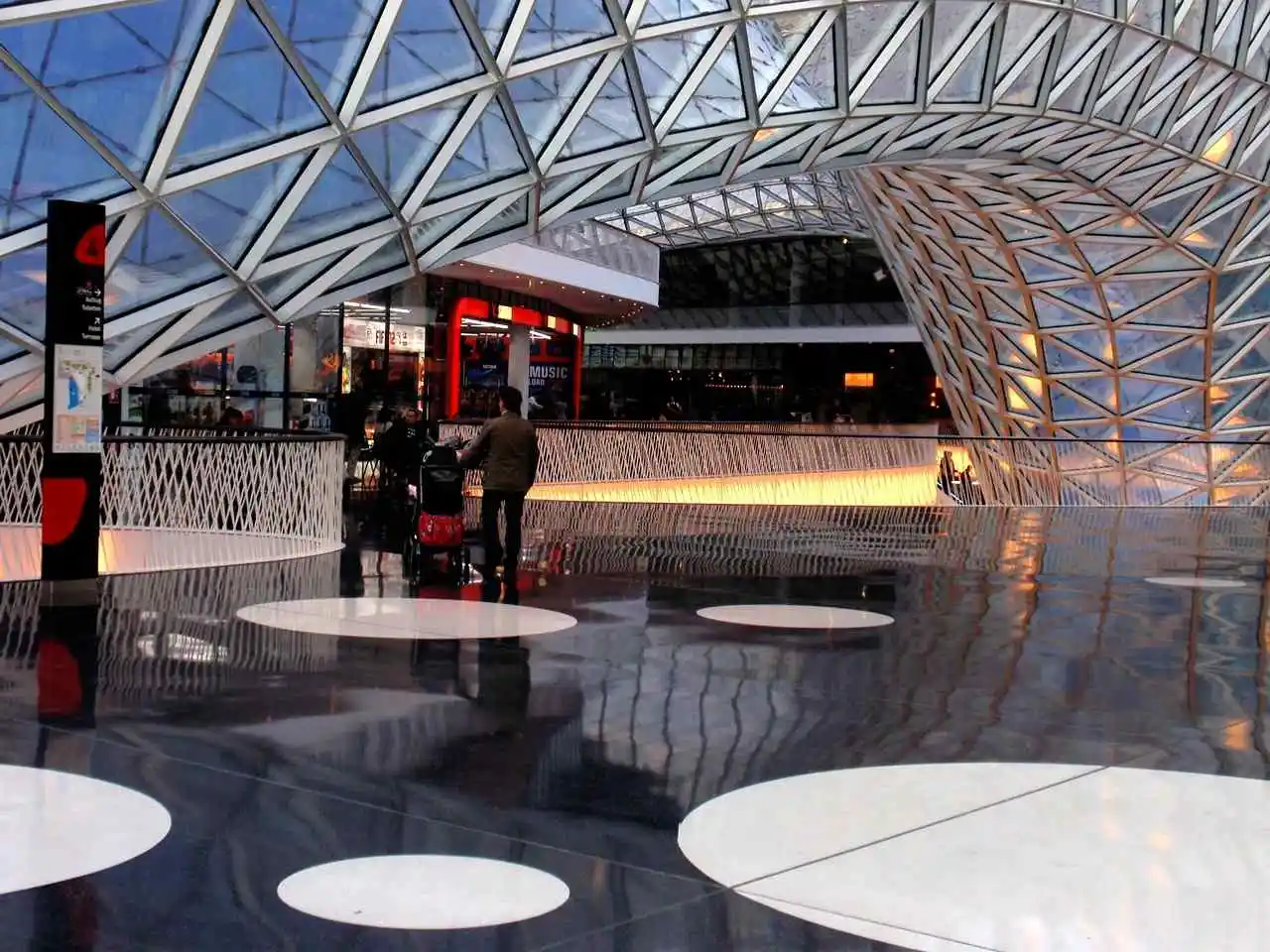
Ever wondered what makes polycarbonate sheets the trendiest product in modern architecture? We are here to tell you about the ins and outs of these marvelous sheets. Once referred to the sidelines as a cost-saving measure for windows, polycarbonate has now taken center stage, revolutionizing architectural design as we know it. Read on why and how polycarbonate sheets in modern architecture are revolutionizing the trends and saving us dollars and our environment, too.
Benefits of using Polycarbonate sheets in modern architecture
Flexibility in Design
Flexibility is the number one consideration in modern architectural design, and polycarbonate sheets are here to meet these flexible needs. With their flexible nature and lightweight build, they offer architects the freedom to explore creative possibilities that are almost impossible when working with counter options like glass or concrete. These sheets can be molded into various shapes without compromising on strength, enabling the realization of bold and innovative architectural designs. From smooth curved surfaces, translucent walls, or intricate architectural details, polycarbonate offers plenty of possibilities. Moreover, these sheets are lightweight, which further enhances their flexibility, simplifies installation, and enables access to hard-to-reach areas.
Moreover, the versatility of polycarbonate extends beyond its structural attributes. These sheets are available in a range of colors, from crystal clear to opaque. Therefore, architects are provided with a range of options to express their aesthetic visions.
They offer durability and safety.
Durability and safety are key pillars of polycarbonate’s appeal in modern architecture. Renowned for its exceptional strength and elasticity, polycarbonate stands are becoming famous in the construction industry. Its virtually unbreakable nature makes it an ideal candidate for buildings demanding top-tier security, including schools, hospitals, and public facilities. With its robust resistance to impacts, polycarbonate emerges as the material of choice in regions susceptible to damage or harsh weather, offering a secure and enduring solution for architects and building owners.
These sheets are cost-effective.
The cost factor is also one of the main factors to consider when we are choosing the best material for construction at a low cost, but at the same time, we do not want to compromise on quality. Cost-effectiveness is a defining feature of polycarbonate panels in modern architecture. Not only do they help reduce expenses associated with heating, cooling, and lighting, but their lightweight composition also translates to decreased structural support requirements compared to glass. This not only potentially cuts down on freight costs but also facilitates easier installation. Moreover, their durability and low maintenance requirements further contribute to long-term savings, making polycarbonate panels a smart investment for architects and builders aiming to balance budget considerations without compromising quality.
They keep out heat, noise, and cold.
Polycarbonate sheets, especially multiwall panels, offer superb thermal insulation properties. Their multi-layered structure traps air, effectively curbing heat transfer and enhancing the energy efficiency of buildings. This translates to substantial savings on heating and cooling expenses. Opting for polycarbonate is not just a short-term decision; it’s a commitment to long-term environmental responsibility, particularly in constructing energy-efficient buildings.
Moreover, polycarbonate excels in acoustic insulation, making it a perfect choice for environments where noise control is essential. Whether you aim to keep external noise out or internal sounds contained, polycarbonate proves its worth in maintaining serene and comfortable spaces.
They are easy to install and handle
Ease of installation, handling, and mobility are standout features of polycarbonate sheets. Their lightweight nature streamlines the installation process, slashing time and labor costs compared to heavier alternatives like glass or metal. Consider the logistics of transporting and maneuvering large quantities of glass, no doubt a hefty work that not only incurs significant fuel expenses but also poses safety risks in handling. Accidental drops could result in both danger and financial strain.
Polycarbonate sheets offer a refreshing contrast. They can be easily cut and shaped on-site using standard tools, further streamlining installation procedures.
They fight fire
Fire safety is critical in any residential, commercial, or industrial setting. Selecting materials that withstand fire is imperative for protecting residents and property. Among its many benefits, polycarbonate has impressive fire resistance capabilities. With a high ignition temperature, polycarbonate requires intense heat to ignite, and its self-extinguishing properties further enhance safety measures. By incorporating polycarbonate into architectural designs, developers and designers prioritize the safety and well-being of building occupants.
They help the environment.
Making environmentally responsible choices in construction projects involves carefully assessing the carbon footprint of building materials. While polycarbonate might carry a hefty environmental burden, studies indicate otherwise. Polycarbonate often emerges as a more sustainable option than conventional materials like glass and aluminum.
Moreover, the end-of-life phase is crucial in the sustainability equation. Polycarbonate offers promising recycling options, allowing for the creation of new products or the repurposing of existing ones. This not only minimizes waste but also reduces overall environmental impact. Furthermore, achieving LEED certification underscores the commitment to sustainability by recognizing projects that embrace eco-friendly practices, including using recyclable materials such as polycarbonate.
They can be textured and tinted.
Adding character and ambiance to architectural designs, polycarbonate offers a diverse range of tints and textures, each influencing the transmission of visible light uniquely. Imagine a south-facing wall adorned with bottle-green polycarbonate, casting a gentle, otherworldly glow throughout the entry gallery of a house. Such versatility in tinting and texturing allows architects to infuse spaces with distinctive atmospheres, enhancing both aesthetics and functionality.
FAQs
Q: What role does polycarbonate play in architecture?
A: Polycarbonate is a versatile alternative to glass in various window and skylight installations. These panels and sheets enable the passage of natural light into buildings and can also be tinted to regulate sunlight penetration. Polycarbonate contributes to creating comfortable and energy-efficient indoor environments by reducing interior reflections and cooling costs.
Q: What makes polycarbonate special?
A: Polycarbonate stands out as a durable and transparent plastic renowned for its exceptional strength, stiffness, and resistance to impact. Its optical clarity lends itself well to various applications, including machine guards, signs, architectural glazing, face shields, skylights, and POP displays.
Q: What thicknesses are available for polycarbonate in architecture?
A: Multiwall polycarbonate sheets come in various layers and thicknesses. Twin-walled polycarbonates, for instance, feature two walls stacked on top of each other and are available in 4mm, 6mm, and 10mm thickness options.
Final thoughts
In today’s architectural landscape, where beauty and functionality converge seamlessly, polycarbonate stands out as a game-changer. Its ability to bathe spaces in natural light while boosting energy efficiency underscores its pivotal role in modern construction. At SongXia, we take pride in being wholesale suppliers of premium polycarbonate sheets, offering tailored solutions to architects and builders worldwide. As we push the boundaries of innovation with this versatile material, we eagerly anticipate witnessing its further integration into sustainable and inspiring architectural projects of tomorrow.
Meta description: Explore the transformative role of polycarbonate sheets in modern architecture. Explore their versatility, durability, and innovative design possibilities.
